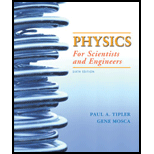
Concept explainers
(a)
The value of
(a)
Answer to Problem 77P
The value of
Explanation of Solution
Given:
The distribution of charge density is
The value of most probable distance of electron from the proton is
Formula used:
The expression for charge in a spherical shell is given by,
Calculation:
The value of
Using the integral table,
On comparing and solving further,
Conclusion:
Therefore, the value of
(b)
The electrostatic potential as a function of the distance
(b)
Answer to Problem 77P
The electrostatic potential as a function of the distance
Explanation of Solution
Formula used:
The expression for electrostatic potential of the proton is given by,
The expression for the charge of the proton is given by:
The expression for electrostatic potential of the electron is given by,
The total electrostatic potential of the system is given by:
Calculation:
The charge of the proton is calculated as
Using the integral table,
The electrostatic potential of the proton is calculated as,
Similarly,
Using the integral table,
The net electrostatic potential is calculated as:
Conclusion:
Therefore,the electrostatic potential as a function of the distance
Want to see more full solutions like this?
Chapter 23 Solutions
Physics For Scientists And Engineers
- In the classical model of a hydrogen atom, an electron orbits a proton with a kinetic energy of +13.6 eV and an electric potential energy of −27.2 eV. HINT (a) Use the kinetic energy to calculate the classical orbital speed (in m/s). m/s (b) Use the electric potential energy to calculate the classical orbital radius (in m). marrow_forwardIn the classical model of a hydrogen atom, an electron orbits a proton with a kinetic energy of +13.6 eV and an electric potential energy of −27.2 eV. (a) Use the kinetic energy to calculate the classical orbital speed (in m/s). m/s (b) Use the electric potential energy to calculate the classical orbital radius (in m). marrow_forwardCalculate the number of angles that L can make with the z-axis for an l=3 electron.arrow_forward
- How much work is required to set up the four-charge configuration of the figure if q = 8.35 pC, a = 67.9 cm, and the particles are initially infinitely far apart and at rest?arrow_forwardCalculate the radial probability density P(r) for the hydrogen atom in its ground state at (a) r= 0, (b) r = a, and (c) r = 2a, where a is the Bohr radius.arrow_forwardIn the simple Bohr model of the ground state of the hydrogen atom, the electron travels in a circular orbit around a fixed proton. The radius of the orbit is 5.281011m , and the speed of the electron is 2.18106m/s . The mass of an electron is 9.111031kg . What is the force on the electron?arrow_forward
- In a hydrogen atom, the electron and proton are bound at a distance of about 0.53 Å:(a) Estimate the potential energy of the system in eV, taking the zero of the potential energy at infinite separation of the electron from proton. (b) What is the minimum work required to free the electron, given that its kinetic energy in the orbit is half the magnitude of potential energy obtained in (a)? (c) What are the answers to (a) and (b) above if the zero of potential energy is taken at 1.06 Å separation?arrow_forwardIn the simple Bohr model of the ground state of the hydrogen atom, the electron travels in a circular orbit around a fixed proton. The radius of the orbit is 5.28 × 10−11 m, and the speed of the electron is 2.18 × 106 m/s. The mass of an electron is 9.11 × 10−31 kg . What is the force on the electron?arrow_forwardIf a proton and electron are released when they are 2.0 m apart, find the initial acceleration of the electron (in m/s2). The answer (in fundamental SI unit) is ___________ (type the numeric value only)arrow_forward
- What is the electric field of an iron nucleus (Z=26) at a distance of 6.00 x10 -11 m from the nucleus?arrow_forwardThe nucleus of a certain atom is 7.30 fm in diameter and has 76.0 protons. What is the acceleration of another proton 4.00 fm from the surface of the nucleus? - 2.35×1027 m/s2, away from the nucleus- 8.20×1028 m/s2, towards the nucleus- 6.55×1029 m/s2, towards the nucleus- 1.79×1029 m/s2, away from the nucleusarrow_forwardCalculate the magnitude of strength of an electric field at the distance of 12.0 nm from the nucleus of the Uranium-235 atom?arrow_forward
 University Physics Volume 1PhysicsISBN:9781938168277Author:William Moebs, Samuel J. Ling, Jeff SannyPublisher:OpenStax - Rice University
University Physics Volume 1PhysicsISBN:9781938168277Author:William Moebs, Samuel J. Ling, Jeff SannyPublisher:OpenStax - Rice University
